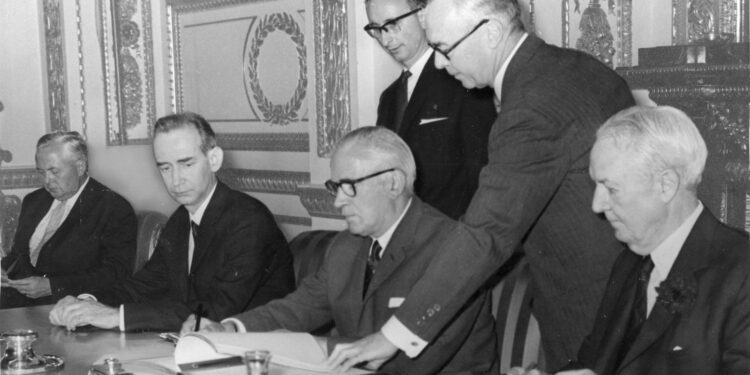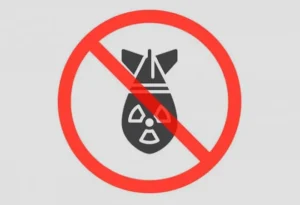What is the Non-Proliferation Treaty?
The Non-Proliferation Treaty (NPT) is a landmark international agreement that aims to prevent the spread of nuclear weapons, promote peaceful uses of nuclear energy, and ultimately achieve nuclear disarmament. It came into effect officially on March 5, 1970, being a cornerstone of global nuclear non-proliferation and disarmament efforts. Opened for signature on July 1, 1968, it was signed at the United Nations in New York City. Initially, 62 countries signed the treaty, and over time, the number of signatories grew to 191. The founding signatories included major nuclear-armed states such as the United States, the Soviet Union (now Russia), the United Kingdom, France, and China.
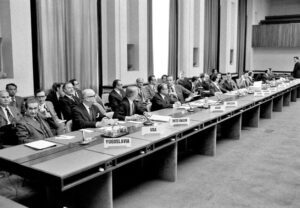
Some Notable Parties:
- Germany
- Japan
- Canada
- Brazil
- South Africa (which dismantled its nuclear weapons program before joining)
- Argentina
- Iran
- Australia
- Egypt
Objectives of the NPT
The primary aim of the Non-Proliferation Treaty remains the safeguarding of peace and the promotion of a non-nuclear global landscape. The treaty’s emphasis lay on promoting the peaceful use of nuclear energy and preventing the spread of nuclear weaponry, especially in countries not yet in possession of a nuclear program.
The treaty is divided into three main objectives:
Non-Proliferation:
The treaty aims to prevent the spread of nuclear weapons and nuclear weapon technology to countries that do not already possess them. It seeks to curb the proliferation of nuclear weapons and maintain global security. To essentially prevent the spread of nuclear weaponry, nuclear-weapon states, defined as those that had tested nuclear weapons before the treaty entered into force, agree not to transfer nuclear weapons or assist non-nuclear-weapon states in acquiring them. Meanwhile, non-nuclear-weapon states agree not to develop or acquire nuclear weapons.
Disarmament:
The treaty, to maintain global peace and security, promotes efforts toward the reduction and eventual elimination of nuclear weapons. It encourages ongoing negotiations and measures to achieve disarmament. All parties, including nuclear-weapon states, are committed to pursuing disarmament negotiations and achieving general and complete disarmament under strict and effective international control.
Peaceful Use of Nuclear Energy:
To coordinate and let peace and growth co-exist side by side, the treaty recognizes the right of all parties to develop and use nuclear energy for peaceful purposes. It facilitates international cooperation in the peaceful use of nuclear technology, including research and development. Countries are encouraged to share nuclear technology for peaceful purposes, such as energy generation and medical applications while ensuring that such uses do not contribute to nuclear weapons proliferation.
Monitoring and Reviews
The IAEA (International Atomic Energy Agency) plays a crucial role in verifying compliance with the Non-Proliferation Treaty. It conducts inspections and implements safeguards to ensure that nuclear activities are not diverted to weapons programs. The IAEA reports on compliance to the UN Security Council and General Assembly.
The treaty further includes provisions for review conferences, held every five years, to assess the implementation of the treaty and address issues related to its operation. These conferences provide a forum for member states to discuss progress and challenges in achieving the treaty’s objectives.
Structure of the Non-Proliferation Treaty:
To clarify measures to maintain peace in the region and to ensure coordination in the matter of nuclear non-proliferation and non-promotion, the contract of the treaty presented multiple articles for the signatories’ consideration. These articles enmeshed within them measures to assert control over the threat of nuclear weaponry on a global level, including putting forth clauses for both Nuclear and non-nuclear powers.
Articles I and II:
- Nuclear-weapon states (defined as those that had manufactured and exploded a nuclear weapon before January 1, 1967) agree not to transfer nuclear weapons or other nuclear explosive devices, and not to assist, encourage, or induce any non-nuclear-weapon state to acquire them.
- Non-nuclear-weapon states agree not to receive, manufacture, or acquire nuclear

The treaty’s primary goal- control over nuclear weaponry promotion. weapons or other nuclear explosive devices. These provisions go hand-in-hand to ensure compliance with the non-promotion of nuclear weaponry, the primary goal of the treaty.
The 191 parties to the Non-Proliferation Treaty (NPT) include nearly all of the United Nations member states. Here’s a general breakdown:
A Few Nuclear-Weapon States (NWS) under the NPT:
- United States
- Russia (as the successor state to the Soviet Union)
- United Kingdom
- France
- China
Non-Nuclear-Weapon States (NNWS) under the NPT:
- All other member states of the United Nations except India, Israel, and Pakistan, which have not signed the treaty, and North Korea, which withdrew in 2003.
Article III:
- Non-nuclear-weapon states agree to accept safeguards administered by the International Atomic Energy Agency (IAEA) to verify that their nuclear activities are not diverted to weapons programs. This includes inspections and monitoring of nuclear facilities.
Article IV:
- The treaty recognizes the right of all parties to develop research, production, and use of nuclear energy for peaceful purposes, in conformity with their non-proliferation obligations. It encourages cooperation in the field of peaceful nuclear technology, so as to bridge the distance between growth and peace.
Article VI:
- This article commits all parties to pursue negotiations in good faith on measures relating to nuclear disarmament and cessation of the nuclear arms race. This includes the goal of a treaty on general and complete disarmament under strict and effective international control, ensuring collective coordination but also general goodwill amongst signatories.
Challenges and Criticism
Despite its broad acceptance and significant achievements, the Non-Proliferation Treaty faces several challenges. Critics argue that nuclear-weapon states have not made sufficient progress toward disarmament, as required by Article VI. This creates tension between nuclear-weapon and non–nuclear states, due to a fragile sense of security that remains threatened by the imbalance of power titled towards the nuclear-weapon states.
Additionally, the continued development of nuclear weapons by states that are not parties to the Non-Proliferation Treaty, such as India, Israel, and Pakistan, challenges the treaty’s non-proliferation goals. This increases the insecurity in states abiding by the treaty and leaves them feeling wary of these states, imbalancing the sense of global security followed only by a few.
Instances of non-compliance, such as North Korea’s withdrawal from the treaty and subsequent nuclear development, highlight difficulties in enforcing the Non-Proliferation Treaty’s provisions. The treaty’s method of enforcement and its weaknesses are showcased through acts like this, calling attention to the fact that there is no proper enforcement of the treaty and establishing the insignificance of non-compliance.
21st Century: Can The Non-Proliferation Treaty Save the World from a Nuclear War?
The Non-Proliferation Treaty (NPT) is a crucial tool for preventing the spread of nuclear weapons and fostering disarmament, but it alone cannot stop a nuclear war today. Here’s why:
- Preventive Framework: The NPT aims to prevent the proliferation of nuclear weapons by promoting disarmament among nuclear-weapon states and discouraging other countries from developing nuclear capabilities. While it has contributed to reducing the number of nuclear weapons and preventing their spread, it cannot directly intervene in the geopolitical tensions or conflicts that could lead to nuclear war.
- Existing Arsenals: Nuclear-weapon states under the NPT have significant arsenals, and tensions among major powers persist. The NPT’s focus is on non-proliferation and disarmament, but existing nuclear stockpiles and the potential for escalation remain a concern.
- Diplomatic Efforts Needed: Preventing a nuclear conflict requires comprehensive diplomatic efforts, conflict resolution, and strategic stability measures beyond the NPT’s framework. Addressing regional conflicts, improving communication channels, and engaging in arms control agreements are essential for reducing the risk of nuclear war.
- Global Cooperation: The NPT’s success depends on the commitment and cooperation of its member states. Effective implementation of its goals, coupled with international collaboration on security and disarmament, is crucial for mitigating the threat of nuclear war.
Non-Nuclear-Weapon States (NNWS) under the NPT: a matter of concern: With an arsenal in the pocket giving them a significant power imbalance, the NNWS becomes a matter of concern to the rest of the world and threaten unsettle the world order. The states include:
-
- India is a concern because it is a significant regional power with an established nuclear weapons program. Its nuclear arsenal, combined with its strategic rivalry with neighboring countries like Pakistan and China, raises concerns about nuclear proliferation and regional stability. India’s decision not to join the NPT reflects its stance on nuclear deterrence and its belief that the treaty unfairly benefits the existing nuclear-weapon states while hindering the security of countries outside the NPT framework.
- Israel has a policy of ambiguity regarding its nuclear weapons program, neither confirming nor denying its existence. This ambiguity, coupled with regional tensions and conflicts, especially with neighboring countries and militant groups, contributes to global concern. The lack of transparency and the possibility of an undisclosed nuclear arsenal in a volatile region add to the complexities of arms control and non-proliferation efforts.
- Pakistan is a major concern due to its nuclear capabilities and ongoing tensions with India. The nuclear rivalry between the two countries increases the risk of a nuclear conflict in South Asia. Additionally, Pakistan’s nuclear program has faced scrutiny regarding its security measures and potential for nuclear technology proliferation. The country’s strategic positioning and ongoing conflicts contribute to global anxiety about nuclear stability and the risk of weapons falling into the hands of non-state actors.
- North Korea poses a significant global threat due to its active nuclear weapons program and frequent missile tests. Its withdrawal from the NPT in 2003, coupled with its aggressive stance and unpredictable behavior, raises concerns about nuclear proliferation in an unstable region. North Korea’s actions challenge international non-proliferation norms and contribute to regional and global security instability.
North Korea and the Non-Proliferation Treaty
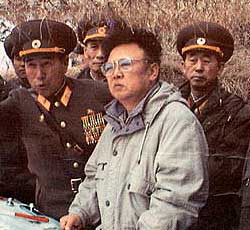
North Korea’s relationship with the Non-Proliferation Treaty has been fraught with tension and controversy. Originally a signatory, North Korea joined the treaty in 1985 as a non-nuclear-weapon state. However, by the early 2000s, suspicions about its nuclear ambitions led to heightened scrutiny. In 2003, North Korea announced its withdrawal from the treaty, a move that significantly impacted global non-proliferation efforts.

Since its withdrawal, North Korea has conducted several nuclear tests, with its most recent tests occurring in 2017. These tests have escalated regional and global security concerns and have been widely condemned by the international community.
The United Nations Security Council has imposed multiple sanctions on North Korea in response to its nuclear activities. Despite these measures, North Korea has continued to develop and advance its nuclear weapons program, with no concern for the treaty. This has established a sense of insecurity to the signatories, imposing a non-serious image regarding the Treaty.
Recent developments include North Korea’s declaration of itself as a nuclear state, emphasizing its right to maintain and develop its nuclear arsenal. This stance undermines the Non-Proliferation goal of preventing the spread of nuclear weapons and raises concerns about the stability of international security. It goes fully against the provisions of the treaty and urges other states to follow suit.
South Korea and the Non-Proliferation Treaty
South Korea, unlike North Korea, remains a committed member of the Non-Proliferation Treaty. As a non-nuclear-weapon state, South Korea has adhered to the treaty’s obligations and has actively participated in global non-proliferation efforts. However, recent geopolitical developments have sparked debates about South Korea’s nuclear policy.
Amid growing tensions with North Korea and ongoing concerns about regional security, some South Korean politicians and analysts have advocated for revising the country’s nuclear posture. This discussion is fuelled by North Korea’s aggressive nuclear development and the perceived inadequacies of the current security arrangements. This debate, although coming into focus to maintain the safety of the region, is seen as a step towards the de-escalation of national safety and may signify the beginning of the development of nuclear programs by other states.
Hence resultantly, in recent years, there has been speculation about South Korea potentially seeking to develop its own nuclear weapons as a deterrent against North Korean threats. However, South Korea remains officially committed to the Non-Proliferation Treaty and continues to advocate for a denuclearized Korean Peninsula. The South Korean government has emphasized its reliance on extended deterrence provided by the United States and has supported international efforts to denuclearize North Korea through diplomatic means.
Implications of a Nuclear Korea
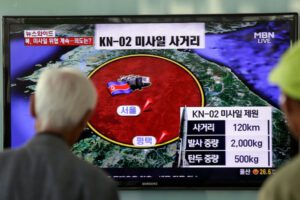
North Korea’s nuclear activities and South Korea’s discussions about potential nuclear development present significant challenges to the Non-Proliferation Treaty’s framework. North Korea’s defiance of the treaty undermines the treaty’s non-proliferation goals and poses a direct threat to regional and global security.
The international community faces difficulties in addressing North Korea’s actions effectively, as diplomatic efforts and sanctions have thus far been insufficient to halt its nuclear program. This fuels not just a threat to the sovereignty and safety of other states but further showcases the insignificance of non-compliance with the Non-Proliferation Treaty.
For South Korea, the debate over its nuclear policy highlights the complex security dynamics in the region. While South Korea’s official stance remains in line with the treaty, the increasing pressure and perceived threats from North Korea continue to influence discussions about its future security strategy.
The prospect of South Korea developing its own nuclear weapons could have far-reaching implications for regional stability and the integrity of the Non-Proliferation Treaty. On one hand, the threat to the state’s security and peace urges it to take steps to develop its own nuclear system, and that development promises a dangerous world order ahead with the prospect of non-compliance from more states.
International Response and Future Directions
The international community continues to respond to these challenges with a mix of diplomatic, economic, and security measures. Efforts to engage North Korea in dialogue and negotiations, such as the Six-Party Talks and other multilateral initiatives, aim to address its nuclear ambitions and bring it back into compliance with the Non-Proliferation Treaty’s framework.
For South Korea, continued engagement with global non-proliferation efforts and adherence to the treaty are crucial in maintaining its commitment to a denuclearized Korean Peninsula. The role of international allies, particularly the United States, remains pivotal in supporting South Korea’s security needs while upholding the principles of the Non-Proliferation Treaty.
The Deterioration of Peace?
The Non-Proliferation Treaty faces significant challenges in light of recent developments with North and South Korea. North Korea’s nuclear activities pose a direct threat to the treaty’s non-proliferation goals, while discussions in South Korea about its nuclear policy reflect the complex security dynamics of the region. Addressing these challenges requires a coordinated international response, continued diplomatic efforts, and a reaffirmation of commitment to the NPT’s core principles. The future of nuclear non-proliferation in the region will depend on the ability of all parties to navigate these issues and work towards a stable and secure global environment.
To find out more about the treaty, The IAEA and the Non-Proliferation Treaty presents the framework.
Read More Stories:
South Korea Highlights Growing Russia-North Korea Military Ties
North Korea Mulling Nuclear Test Around US Election, South Korea Warns
Russia Considers Adjusting Nuclear Doctrine Amid Rising Threats

